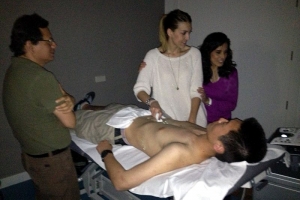The Master students of Urgencies, Emergencies and Catastrophes could enjoy an specific module of diagnostic sonography in their programme.
03/06/2013
Last Thursday, (23, May) the Master students of Urgencies, Emergencies and Catastrophes could make practices of diagnostic sonography over the five hours this specific module lasted.
Last Thursday, (23, May) the Master students of Urgencies, Emergencies and Catastrophes could make practices of sonogram (ultrasounds) over the five hours the specific module of this subject lasted. During this time, after Dr. Jesús Canora, of the Internal Service at the Hospital in Fuenlabrada, explained in an easy way the basic concepts when identifying by means of a sonography the main syndromes dealing with urgencies, students could try out the use of this tool.
Within the competences they have to acquire the urgencies doctors, sonography has been proved as a fundamental tool that allows complementing the level of excellence. There are unmistakable evidences in favour of this technique, highlighting that is a cheap technique, harmless for the patient, with a surprisingly small learning curve, highly reproducible and that provides very valuable information to the doctor in a short period of time.
The main objectives of the module were:
1. Basic Echocardiography: centred in the estimation of the fraction of ejection in the assessment of the hypotonic patient, the detection of the pericardial effusion as a result of clinically meaningful low blood pressure and the increase of the size of the right ventricle as suggestive sign of TEP.
2. Sonography when triaging a polytraumatized patient: including the FAST and E-FAST protocols. Detection of haemoperitoneoum, haemothorax, pericardial effusion and collapsed lungs in the context of a polytraumatism.
3. Aortic sonogram: detection of the aneurysm of the abdominal aortic and the bifurcation of the iliac arteries.
4. Thoracic sonogram: diagnosis approach in acute respiratory failure, such as pneumothorax, EPOC acutization phenomenon, atelectasis, interstitial syndrome, etc.
5. Sonogram-guided procedures: support when channelling the central and peripheral tracts, thoracocentesis, paracentesis, lumbar puncture, pericardiocentesis, etc...
The Master of Urgencies, Emergencies and Catastrophes organized by USP-CEU and TASSICA covers an academic year. It is recognised by ANECA - with 60 ECTS credits – as a University Master of Postgraduate Studies. It also accomplishes the requirements of the Consejería of Sanidad (Health Ministry) of the Community of Madrid in order to recognize the professional competence in activities related to patient transportation.




 2016_988e4d.jpg)

